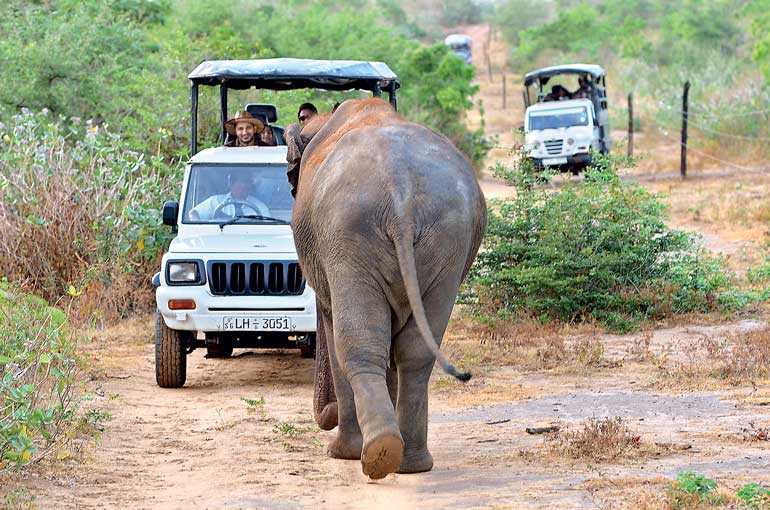Tuesday Mar 11, 2025
Tuesday Mar 11, 2025
Tuesday, 18 September 2018 00:00 - - {{hitsCtrl.values.hits}}

Ecotourism is the lucrative trend within the industry that entertains visitors within natural and relatively undisturbed environments – Pic by Shehan Gunasekara
By Piyumani Ranasinghe
The story of Sri Lankan tourism is now turning out to be one of misadventure than satisfaction, given the unregulated nature of the entire enterprise and the resulting environmental consequences.
Although the post-war era has witnessed a boost in the island nation’s tourist industry in general, it continues to exist as an untapped economic potential according to the 2017-2020 Tourism Strategic Plan (TSP) drafted by the Ministry of Tourist Development and Christian Religious Affairs.
The plan mainly highlights that the country is missing opportunities in increasing investment and employment within tourism, which hinders its ability to utilise tourism revenues to conserve the environment and sustainably support local communities. Quite alarmingly, it also translates into the country lacking a long-term view of sustaining the industry, balancing the socio-economic carrots (such as revenue and employment opportunities) with the economic externalities, such as environmental costs.
Interestingly, the TSP has recommended actions and implementation mechanisms aiming at a four-year plan, with a panoramic view of the United Nations Sustainable Developmental Goals (UNSDGs) and ecotourism. It also highlights the importance of a collaborative role engulfing all stakeholders concerned: government, investors, communities, visitors, etc.
However, a plan only looks good on paper if actions are yet to be successfully implemented. This includes mechanisms for continuous monitoring as well as evaluation. It should be borne in mind that any case of mismanagement can lead to consequences that outlive the momentary enjoyment of pristine environments.
Although the task of environmental protection is not an exclusive job at the hands of the Government or one stakeholder per se, the Government holds direct as well as indirect responsibility to environmental costs incurred within the industry as it is the main regulatory body. The unattractive cross-section of unregulated tourism not only raises the red flag of environmental degradation, but also pinpoints at the economic liabilities it incurs on the industry in the longer run.
Ecotourism in Sri Lanka: An attempt at green-washing?
Ecotourism is the lucrative trend within the industry that entertains visitors within natural and relatively undisturbed environments. The Nature Conservancy and the World Conservation Union have defined ecotourism as the “environmentally responsible travel to natural areas in order to enjoy and appreciate nature (and accompanying cultural features both past and present) that promote conservation, have a low visitor impact, and provide for beneficially active socio-economic involvement of local people”.
In this way, although ecotourism can enhance economic development, conservation of protected areas by providing local employment and community ownership, and generate revenues to sustainably manage protected areas, without careful planning and management in balancing ecological, social, and economic objectives, the impact on the environment can be cataclysmic. Beneath the absence of planning, implementation and consistent follow-through in terms of projects, underlies the very issue of unregulated tourism in Sri Lanka, leading to an array of environmental calamities.
For example, the natural environment and its quality can deteriorate due to inappropriate design of latrines, septic tanks, and solid waste. Along with the construction of leisure establishments, hotels and holiday homes, deforestation and the destruction of unique flora takes place. To meet the definition of ecotourism, trips must involve visiting natural environments, doing nothing to change or adversely affect these areas, and providing cultural and economic advantages to local communities.
Since there is no clear way to enforce these requirements in most instances, and given that businesses can advertise trips as ecotourism even when they aren’t environmentally responsible, ‘green-washing’ is inevitable in Sri Lanka.
Sewage water rafting in Kitulgala
Kitulgala is an interesting case of such unregulated tourism, where white water rafting across the cascading Kelani River is now an adventure in waters direly polluted by faecal matter. Samanala Graama Sanvardhane Samithiya, a community based organisation (CBO), complains that sewage of leisure services establishments alongside the river is released to the river given the lack of monitoring by the Government agencies. Some of the establishments are directly placed on the river bank, which is illegal in itself.
Quite tragically, the issue of sewage contamination heightens when large groups of guests arrive en route to Adam’s Peak during the seasonal months. Moreover, due to the poor solid waste management system, there have been instances where leisure establishments had directly disposed solid waste into the river. Environmental Foundation Ltd. (EFL) notes that it received a complaint from the CBO in May 2017of a microbiology water test conducted by the Water Resources Board as per a request made by the Ministry of Irrigation and Water Management.
The results of the test indicated a rise in pollution levels, where the cleanliness of the water was deemed unsatisfactory. Whilst the bacteriological requirement for potable water under SLS 614:2013 of E.coli in a 100ml sample of water was 0/100ml, the highest recording of total E.coli bacteria at 37°C was 1000/ 100ml in the tested sample of water. Not only is this disgusting, but it is also devastating to the riverine community whose daily requirements of water is sustained by the Kelani River.
EFL notes that it is currently working towards addressing the issue of sewage contamination in the Kelani River surrounding Kitulgala, although the complications of the matter rise with Government agencies working in silos.
The freedom of wild life
Government agencies continue to hibernate through the sorry state of the national parks in Sri Lanka, even if the iconic marine and terrestrial wildlife of the island is a core tourist attraction. Together, they generate significant revenue for conservation of the natural environment, where the revenues incurred from national parks in 2015 alone was over Rs. 15 million. Yet the state of many of these national parks remains dismal and despairing.
The most visited national parks in the last five years include Yala, Horton Plains and Udawalawe. Dolefully, the state of these national parks is unbelievably substandard. Although much has been spoken about Yala, the subject sadly but continuously lingers on due to the persisting issues within the national park, such as rundown vehicles, speeding, crowding at wildlife sites, and poor infrastructure. Ideally, where the revenues generated should be invested in conserving and better managing the environment, the lack of action in either of those ends raises the burning question as to where all that money goes.
Like land-based wildlife tourism, marine tourism management requires stringent Government intervention to ensure a sustainable footing. Three key sites mostly visited to sight blue and sperm whales, dolphins, turtles, spinner dolphins and certain small shark species include Mirissa on the south coast, Trincomalee on the northeast coast, and the Kalpitiya peninsula on the northwest coast.
Yet, as EFL pointed out, there is a major problem in the management of whale-watching, particularly in Mirissa and Kalpitiya, where compact, overloaded, slow boats chase and harass the marine wildlife. The Government should not only implement the internationally recognised regulatory standards for sustainable vessel-based whale watching, but also introduce an Environmental Protection Licence (EPL) to service providers as an incentive to actively recognise the importance of environmentally sound protocols.
The way forward
Some of these case studies are taken into consideration in the aforementioned TSP, which identifies the vitality of environmentally sound mechanisms in addressing the persisting calamities. Yet, it goes without saying that there is a long way forward in successfully ensuring monitoring and evaluation of these steps. Certain loopholes within the regulatory framework have resulted in the destruction of pristine environments, especially under the label of ecotourism.
EFL’s case regarding the Sallitivu Islet in Vakarai, for instance, is a timely example which shows that a tourism project which was carried out under the name ‘Leisure and Pleasure Pristine Eco Culture’, was not even cleared by an Environmental Impact Assessment (EIA) and an Initial Environmental Examination (IEE).
One key issue in this particular case was that an integrated governmental effort was not taken to inhibit the illegal tourism project. Although there is a chunk of literature on sustainable tourism projects practicable to Sri Lanka, including the TSP, and policy recommendations generated by academics and professionals, it has not been incorporated in the policy cycle effectively and certainly has not been followed through by governmental agencies. Thus, the destiny of the unregulated tourism and its consequences remain unresolved and tangled in the web of the Sri Lankan political game.
Praiseworthily, organisations such as EFL work towards the protection of environmental objectives in tourism, which highlights the crucial role of civil society in ensuring accountability of governmental bodies to their actions.
[Piyumani Ranasinghe is an Associate Research Fellow at the Institute of National Security Studies Sri Lanka (INSSSL). She is a graduate of International Relations from the University of London and is currently reading for her LL.B. degree at the University of Peradeniya. Her views are independent.]
Discover Kapruka, the leading online shopping platform in Sri Lanka, where you can conveniently send Gifts and Flowers to your loved ones for any event including Valentine ’s Day. Explore a wide range of popular Shopping Categories on Kapruka, including Toys, Groceries, Electronics, Birthday Cakes, Fruits, Chocolates, Flower Bouquets, Clothing, Watches, Lingerie, Gift Sets and Jewellery. Also if you’re interested in selling with Kapruka, Partner Central by Kapruka is the best solution to start with. Moreover, through Kapruka Global Shop, you can also enjoy the convenience of purchasing products from renowned platforms like Amazon and eBay and have them delivered to Sri Lanka.
Discover Kapruka, the leading online shopping platform in Sri Lanka, where you can conveniently send Gifts and Flowers to your loved ones for any event including Valentine ’s Day. Explore a wide range of popular Shopping Categories on Kapruka, including Toys, Groceries, Electronics, Birthday Cakes, Fruits, Chocolates, Flower Bouquets, Clothing, Watches, Lingerie, Gift Sets and Jewellery. Also if you’re interested in selling with Kapruka, Partner Central by Kapruka is the best solution to start with. Moreover, through Kapruka Global Shop, you can also enjoy the convenience of purchasing products from renowned platforms like Amazon and eBay and have them delivered to Sri Lanka.